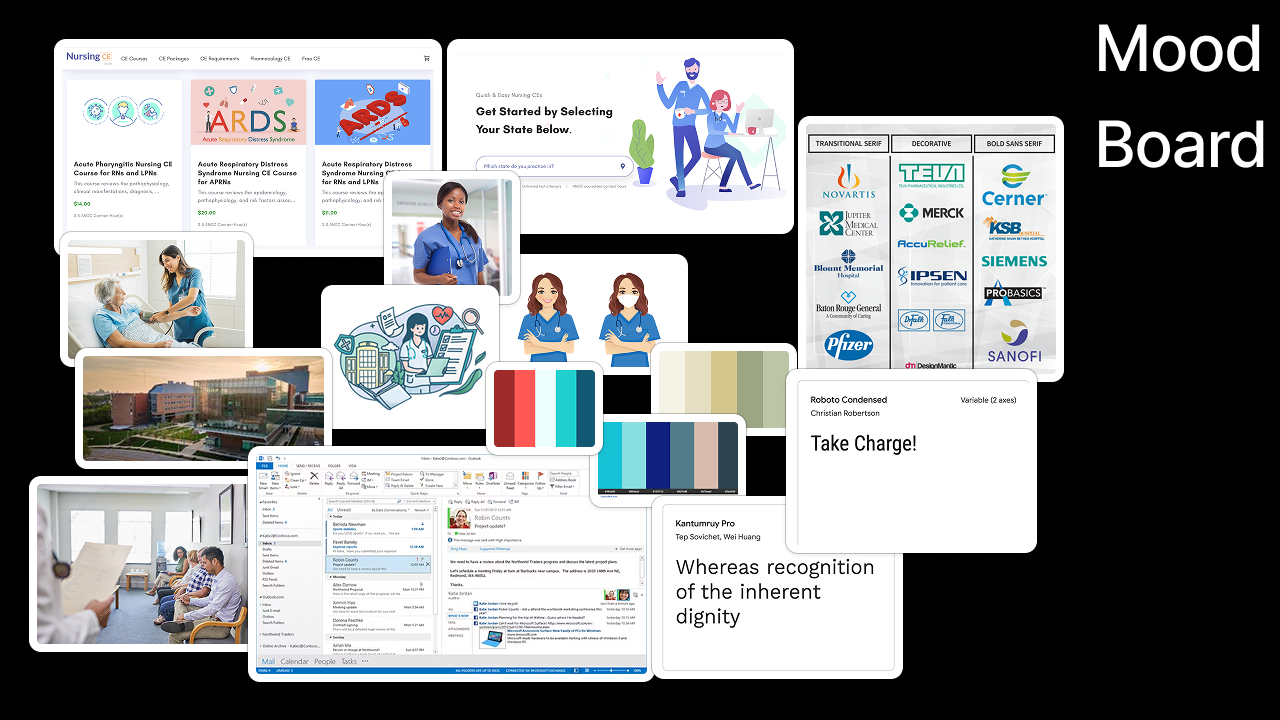Take Charge!
Can you help nurses identify their mistakes?
Audience: Charge Nurses
Responsibilities: Instructional design, action mapping, storyboarding, visual design, prototyping, authoring, eLearning development
Tools Used: Articulate Storyline 360, Vyond, Figma, Adobe Photoshop, Adobe Illustrator, InDesight, Google Suite, FreePik
This concept project is a scenario-based eLearning that helps charge nurses provide actionable feedback to new nurses in a clinic setting.
The Problem
MidAmerica Medical Center (MMC), a fictitious medical system, has clinics across Ohio. Based on survey data, orientation materials and current training are not enough to prevent the majority of new nurses from feeling unprepared to perform the quintessential functions of their job. A combination of data, collaboration with subject matter experts (SMEs), and independent research led me to identify the main cause of low preparedness as low-quality, unactionable feedback from charge nurses during training and observation.
The Solution
The presence of skill gaps suggests a learning solution would be appropriate. An ILT (instructor-led training) and non-learning, materials-based solutions were considered. However, the number of employees and their disbursement across multiple clinic locations make an eLearning solution most applicable. As the main gaps in skill are related to interactions between employees a scenario based eLearning was the best solution.
The Process
To develop the most effective learning solution for MMC, I used the ADDIE model to build out the project. My process starts with a needs assessment and action mapping. Next, I design the storyboard and visuals. Then, the designs are improved, developed, implemented, and evaluated.
Action Map
Through research, I identified actions consistent throughout several performance feedback models. I identified the high-priority action steps that would be the most efficient and effective for creating an actionable solution. I decided that for a single test portion of a large build, we would have charge nurses identify a mistake, describe the observed action, and communicate it without judgment. The process of narrowing focus through action mapping ensures that all of the actions connect to the overall goal.
Text-based Storyboard
With information provided by the SMEs (a nurse and charge nurse at a clinic near me), I was able to develop a realistic text-based storyboard. I included scripting for characters, visual design information, and programming notes. I continuously refined the components of the storyboard throughout the remaining phases of development. The storyboard provided a good foundation for a cohesive, interactive, and engaging learning experience.
Visual Mockups
Using the information from the storyboard, I created visual design mockups of the scenarios. I started with a mood board looking at typical imagery, color patterns, and fonts used in medical learning experiences. Based on what I learned, I created a style guide that was visually pleasing, accessible, and functional. Then I developed wireframes that, over time, became more complex and fleshed out visual mockups. In the design phase, I am building a base for the scenes before they are fully developed, making it efficient for me and consistent for the learner.
Interactive Prototype
The development phase is where the magic happens. I changed my mockups from images, videos, and text into an immersive experience that lends itself to practical application and positive learning outcomes. From the start of development, I consider accessibility, adult learning methodologies, and how the interactivity might affect success. My interactive prototype underwent several versions before being turned into a fully developed project.
Full Development
I received valuable feedback from the SMEs, other instructional designers, and people who knew nothing about the project. Each group provided different insights into the user interface, clarity of the story, and components that were not working appropriately. Most importantly, I received feedback on adapting the story to allow the learner to experience consequences and situations rather than reading about them. From the feedback, I made changes and developed the entire scenario-based eLearning. Next, I gave the full project to the SMEs to test run and evaluate. From that point, the ADDIE model starts over with analyzing the evaluation, adjusting the design, developing, and implementing. At this point, I began to consider the next steps if the eLearning was successful and needed to be expanded to meet the company’s goals.













